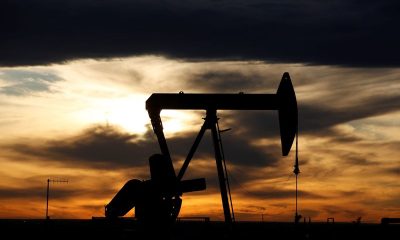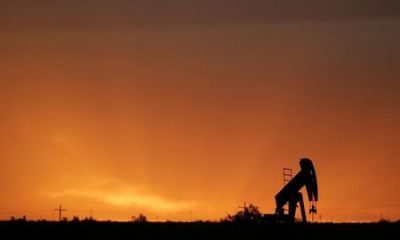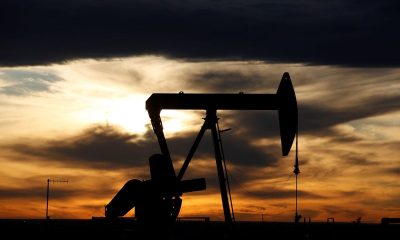Economy
Analysis-U.S. growth, a puzzle to policymakers, could pose global risks


© Reuters. FILE PHOTO: Federal Reserve Chair Jerome Powell, European Central Bank President Christine Lagarde, and Bank of Japan Governor Kazuo Ueda take a break outside while attending the Kansas City Federal Reserve Bank’s annual Economic Policy Symposium in Jacks
By Howard Schneider, Ann Saphir and Balazs Koranyi
JACKSON HOLE, Wyoming (Reuters) – U.S. economic growth, still racing at a potentially inflationary pace as other key parts of the world slow, could pose global risks if it forces Federal Reserve officials to raise interest rates higher than currently expected.
The Fed’s aggressive rate increases last year had the potential to stress the global financial system as the U.S. dollar soared, but the impact was muted by largely synchronized central bank rate hikes and other actions taken by monetary authorities to prevent widespread dollar funding problems for companies and offset the impact of weakening currencies.
Now Brazil, Chile and China have begun cutting interest rates, with others expected to follow, actions that international officials and central bankers at last week’s Jackson Hole conference said are largely tuned to an expectation the Fed won’t raise its rate more than an additional quarter percentage point.
While U.S. inflation has fallen and policymakers largely agree they are nearing the end of rate hikes, economic growth has remained unexpectedly strong, something Fed Chair Jerome Powell noted in remarks on Friday could potentially lead progress on inflation to stall and trigger a central bank response.
That sort of policy shock, at a moment of U.S. economic divergence with the rest of the world, could have significant ripple effects.
“If we get to a point where there is a need for … doing more than what’s already priced in, at some point markets might start getting nervous … Then you see a big increase in the risk premia in different asset classes including emerging markets, including the rest of the world,” said International Monetary Fund chief economist Pierre-Olivier Gourinchas. “The risk of a financial tightening, a very sharp financial tightening, I think we cannot rule that out.”
After the pandemic shock and the inflationary rebound that had most countries raising rates together, it’s normal now for policies to diverge, Cleveland Fed President Loretta Mester told Reuters on the sidelines of the Jackson Hole conference on Saturday.
But a lot rides on the Fed getting it right.
“The economy is a global economy, right? It’s an interconnected economy,” Mester said. “What we do with our policy – if we can get back to 2% in a timely way, in a sustainable way, if we have a strong labor market – that’s good for the global economy.”
GLOBAL DIVERGENCE
Fed policymakers will deliver a crucial update to their economic outlook at a Sept. 19-20 meeting, when they are expected to leave their policy rate unchanged at 5.25% to 5.5%.
If inflation and labor market data continue showing an easing of price and wage pressures, the current forecast for just one more quarter-point increase may hold.
Yet Fed officials remain puzzled, and somewhat concerned, over conflicting signals in the incoming data.
Some point to weakening in manufacturing, slowing consumer spending, and tightening credit, all consistent with the impact of strict monetary policy and cooling price pressures.
But gross domestic product is still expanding at a pace well above what Fed officials regard as the non-inflationary growth rate of around 1.8%. U.S. GDP expanded at a 2.4% annualized rate in the second quarter, and some estimates put the current quarter’s pace at more than twice that.
The contrast with other key global economies is sharp. The euro area grew at an annualized 0.3% in the second quarter, essentially stall speed. Difficulties in China, meanwhile, may drag down global growth the longer they fester.
Quizzed about the divergence after a speech here, European Central Bank President Christine Lagarde noted after the Russian invasion of Ukraine last year, the outlook was for a euro-area recession, and a potentially deep one in parts of it.
Growth, albeit slow, has continued, and inflation has fallen, an overall dynamic not dissimilar to that of the U.S.
“We expected all that to be a lot worse. It has turned out to be much more robust, much more resilient,” Lagarde said.
U.S. fiscal policy is driving some of the difference with $6 trillion in pandemic-era aid still bolstering consumer spending. A recent investment push from the Biden administration is supporting manufacturing and construction.
China may also play a role, economists say. Its slowdown after a short-lived growth burst earlier this year could pinch Germany’s exports and slow Europe’s growth, for instance.
But, Citigroup (NYSE:) Chief Economist Nathan Sheets said, “when you hear economists give you three or four reasons for something, that’s usually because we really don’t know.”
TOO STRONG FOR COMFORT?
The longer the U.S. economy outperforms, the more Fed officials wonder if they understand what’s happening.
A recent improvement in productivity, for example, could explain how inflation continues falling even as growth remains strong.
Under current Fed thinking a period of below-trend growth is needed to drive inflation sustainably back to the 2% target. Key inflation measures are currently more than twice that.
Most officials do think the economy will slow, as tight policy and stringent credit are more fully felt and pandemic-era savings are spent down. Consumer loan delinquencies are starting to rise, and the restart of student loan payments could upend services spending less affected by Fed actions so far.
“There may be significant further drag in the pipeline,” Powell said on Friday, a reason to hold off on further hikes and study how the economy evolves.
But he added the Fed was “attentive to signs that the economy may not be cooling as expected,” with recent consumer spending “especially robust,” and a housing sector “showing signs of picking back up.”
Any significant surge in home prices or rents would undermine the Fed’s view that easing shelter costs would be key in helping to slow the overall pace of price increases.
While the focus is on inflation data, topline economic growth that remains above trend could undermine faith that inflation will fall, and increase concerns that it might rise — an outcome Fed officials view as particularly pernicious and have pledged to avoid.
“Evidence of persistently above-trend growth could put further progress on inflation at risk and could warrant further tightening of monetary policy,” Powell said.
That’s the moment other countries need to watch and prepare for, Gourinchas said.
“The rest of the world has to make sure that they are ready for the potential risk that we’re not there yet in terms of the U.S. disinflation.”
Economy
Russian central bank says it needs months to make sure CPI falling before rate cuts -RBC


© Reuters. Russian Central Bank Governor Elvira Nabiullina attends a news conference in Moscow, Russia June 14, 2019. REUTERS/Shamil Zhumatov/File Photo
MOSCOW (Reuters) – Russia’s central bank will need two to three months to make sure that inflation is steadily declining before taking any decision on interest rate cuts, the bank’s governor Elvira Nabiullina told RBC media on Sunday.
The central bank raised its key interest rate by 100 basis points to 16% earlier in December, hiking for the fifth consecutive meeting in response to stubborn inflation, and suggested that its tightening cycle was nearly over.
Nabiullina said it was not yet clear when exactly the regulator would start cutting rates, however.
“We really need to make sure that inflation is steadily decreasing, that these are not one-off factors that can affect the rate of price growth in a particular month,” she said.
Nabiullina said the bank was taking into account a wide range of indicators but primarily those that “characterize the stability of inflation”.
“This will take two or three months or more – it depends on how much the wide range of indicators that characterize sustainable inflation declines,” she said.
The bank will next convene to set its benchmark rate on Feb. 16.
The governor also said the bank should have started monetary policy tightening earlier than in July, when it embarked on the rate-hiking cycle.
Economy
China identifies second set of projects in $140 billion spending plan


© Reuters. FILE PHOTO: Workers walk past an under-construction area with completed office towers in the background, in Shenzhen’s Qianhai new district, Guangdong province, China August 25, 2023. REUTERS/David Kirton/File Photo
SHANGHAI (Reuters) – China’s top planning body said on Saturday it had identified a second batch of public investment projects, including flood control and disaster relief programmes, under a bond issuance and investment plan announced in October to boost the economy.
With the latest tranche, China has now earmarked more than 800 billion yuan of its 1 trillion yuan ($140 billion) in additional government bond issuance in the fourth quarter, as it focuses on fiscal steps to shore up the flagging economy.
The National Development and Reform Commission (NDRC) said in a statement on Saturday it had identified 9,600 projects with planned investment of more than 560 billion yuan.
China’s economy, the world’s second largest, is struggling to regain its footing post-COVID-19 as policymakers grapple with tepid consumer demand, weak exports, falling foreign investment and a deepening real estate crisis.
The 1 trillion yuan in additional bond issuance will widen China’s 2023 budget deficit ratio to around 3.8 percent from 3 percent, the state-run Xinhua news agency has said.
“Construction of the projects will improve China’s flood control system, emergency response mechanism and disaster relief capabilities, and better protect people’s lives and property, so it is very significant,” the NDRC said.
The agency said it will coordinate with other government bodies to make sure that funds are allocated speedily for investment and that high standards of quality are maintained in project construction.
($1 = 7.1315 renminbi)
Economy
Russian central bank says it needs months to make sure CPI falling before rate cuts -RBC


© Reuters. Russian Central Bank Governor Elvira Nabiullina attends a news conference in Moscow, Russia June 14, 2019. REUTERS/Shamil Zhumatov/File Photo
MOSCOW (Reuters) – Russia’s central bank will need two to three months to make sure that inflation is steadily declining before taking any decision on interest rate cuts, the bank’s governor Elvira Nabiullina told RBC media on Sunday.
The central bank raised its key interest rate by 100 basis points to 16% earlier in December, hiking for the fifth consecutive meeting in response to stubborn inflation, and suggested that its tightening cycle was nearly over.
Nabiullina said it was not yet clear when exactly the regulator would start cutting rates, however.
“We really need to make sure that inflation is steadily decreasing, that these are not one-off factors that can affect the rate of price growth in a particular month,” she said.
Nabiullina said the bank was taking into account a wide range of indicators but primarily those that “characterize the stability of inflation”.
“This will take two or three months or more – it depends on how much the wide range of indicators that characterize sustainable inflation declines,” she said.
The bank will next convene to set its benchmark rate on Feb. 16.
The governor also said the bank should have started monetary policy tightening earlier than in July, when it embarked on the rate-hiking cycle.

 Forex2 years ago
Forex2 years agoForex Today: the dollar is gaining strength amid gloomy sentiment at the start of the Fed’s week

 Forex2 years ago
Forex2 years agoHow is the Australian dollar doing today?

 Forex1 year ago
Forex1 year agoUnbiased review of Pocket Option broker

 Forex2 years ago
Forex2 years agoDollar to pound sterling exchange rate today: Pound plummeted to its lowest since 1985

 Cryptocurrency2 years ago
Cryptocurrency2 years agoWhat happened in the crypto market – current events today

 World2 years ago
World2 years agoWhy are modern video games an art form?

 Stock Markets2 years ago
Stock Markets2 years agoMorgan Stanley: bear market rally to continue

 Economy2 years ago
Economy2 years agoCrude oil tankers double in price due to EU anti-Russian sanctions

































